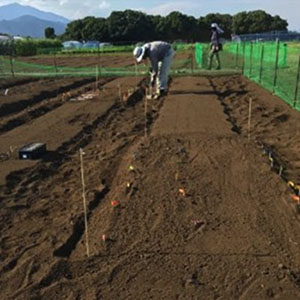Selection of p-nitrophenyl fatty acid substrate suitable for detecting changes in soil esterase activity associated with degradation of biodegradable polyester mulch films: A field trial

Accepted: 1 May 2022
HTML: 236
All claims expressed in this article are solely those of the authors and do not necessarily represent those of their affiliated organizations, or those of the publisher, the editors and the reviewers. Any product that may be evaluated in this article or claim that may be made by its manufacturer is not guaranteed or endorsed by the publisher.
This study aimed to develop a method for detecting microbial activity based on soil esterase activity during the biodegradation of polyester biodegradable mulch films after ploughing the field. Herein, we report that the p-nitrophenyl butyrate (pNP–C4) substrate, among five pNP fatty acid substrates [pNP–acetate (C2), – C4, –hexanoate (C6), –decanoate (C10), and –dodecanoate (C12)] in a cultivated field, is a specific indicator for detecting microbial activity associated with biodegradation of biodegradable polyesters. To evaluate film degradation by loss of weight and visual area, pieces of three different films were placed independently in meshed plastic bags and buried in a cultivated field in Japan for seven months. One was made from poly(butylene succinate-co-adipate) (PBSA), and two were (poly(butylene terephthalate-co-adipate) and poly(butylene succinate)-type polymer)- based commercial biodegradable mulch films (hereafter described as films A and B) and weathered for three months in the cultivated field. The soil adhered to the mesh bag and film was retrieved and mixed, and their esterase activities were measured using the five pNP fatty acid substrates. From the loss of visual area, the time taken from burial to accelerated degradation increased, in the order of PBSA, film A, and film B. The reproducibility of the hydrolytic activity values of pNP–C2, –C4, and –C6 in bulk soil were considered sufficient to measure baselines for the enzymatic activities. Among these substrates, the hydrolytic activity of pNP– C4 was significantly higher in the degradation process of PBSA and film A. In addition, unlike the pNP–C2 and –C6, the hydrolytic activity of the pNP–C4 in the bulk soil was not affected by changes in soil temperature and moisture under the conditions of this experiment. Therefore, the pNP–C4 hydrolytic activity can aid in the detection of the microbial activity associated with the biodegradation of polyester-based biodegradable mulch films in cultivated field soils.
Highlights
- Biodegradable poly(butylene succinate-co-adipate) and two commercial films had different field degradation rates.
- Five p-nitrophenyl (pNP) fatty acid substrates were investigated to evaluate esterase activity in the soils.
- Three pNP substrates with shorter acyl chains could stably indicate an increase in hydrolytic activity with film degradation.
- In these substrates, the hydrolytic activities of pNP-acetate and -hexanoate were related to soil temperature and moisture, respectively.
- The hydrolytic activity of pNP-butyrate was a suitable indicator of the microbial activity associated with the film degradation.
How to Cite

This work is licensed under a Creative Commons Attribution-NonCommercial 4.0 International License.
PAGEPress has chosen to apply the Creative Commons Attribution NonCommercial 4.0 International License (CC BY-NC 4.0) to all manuscripts to be published.

 https://doi.org/10.4081/ija.2022.2040
https://doi.org/10.4081/ija.2022.2040







